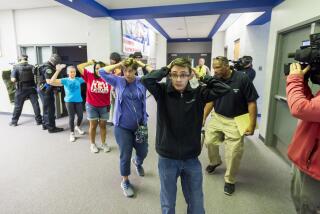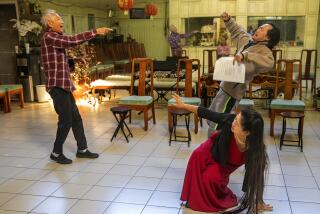Slain sergeant’s rapid response to Thousand Oaks mass shooting was shaped by previous tragedies, failures

There was a cold math to Ron Helus’ actions when he arrived at the Borderline Bar and Grill earlier this week.
Gunshots could still be heard as the veteran Ventura County sheriff’s sergeant, himself a former SWAT officer, pulled up outside the popular Thousand Oaks venue. Just two minutes earlier, Ian David Long had tossed a smoke bomb onto the dance floor during college night and began spraying the room with bullets.
Experts say that nearly all the victims of an active shooter incident will usually be killed or wounded in the first eight minutes. Helus was inside that window, with a chance to interrupt the shooter’s rampage and stop him from killing without resistance.
But he also was about to change the shooter’s focus. A study published by the Police Executive Research Forum in 2014 showed that nearly 33% of police officers who make a “solo entry” to an active shooter situation will be shot.
While Helus was flanked by a California Highway Patrol officer, experts say he was putting himself at an extreme, and deadly, disadvantage. Still, they said, it was a choice he had to make, despite the obvious risk.
“Even if we can’t stop it, if we can interrupt his killing spree, we can save lives,” said Sid Heal, a retired Los Angeles County sheriff’s commander who is now president of the California Assn. of Tactical Officers. “But then we become the target.”
It remains unclear whether Long was felled by police gunfire or a self-inflicted wound after he was confronted, but most police officials agree Helus’ quick actions almost certainly lessened the potential body count from Wednesday’s attack.
The conventional wisdom about police responses to mass shooting incidents was fundamentally changed the day two students walked into Columbine High School in Colorado in 1999 and killed 13 people. Police SWAT teams waited nearly 45 minutes to enter the building. Studies of the incident have concluded that direct confrontation with an active shooter can greatly reduce the number of victims.
The tactics used during incidents like the one in Thousand Oaks have been shaped by the consequences of decisions made during other violent sieges on schools, nightclubs and office buildings in the U.S.
In recent years, police have come under criticism after being perceived as slow to confront active shooters, with some blaming those decisions for leading to more bloodshed.
Several survivors of the 2016 Pulse night club shooting in Orlando, Fla., which left 49 dead, criticized responding officers for not confronting gunman Omar Mateen sooner, allowing the attack to continue for several hours and devolve into a hostage standoff. A Broward County, Fla., sheriff’s deputy also faced criticism earlier this year after video showed him failing to intervene during a shooting at Marjory Stoneman Douglas High School that left 17 dead.
In other recent attacks, quick police action has been credited with helping short-circuit potential massacres. Two U.S. Capitol Police officers were hailed as heroes last year when they immediately entered into a firefight with a gunman who attacked a group of Republican legislators practicing for a baseball game.
“That’s a tactic we call immediate action, rapid deployment. … It should be in the DNA of American law enforcement now, after all these tragedies that have occurred in the U.S. in the last 10 years,” said Michael Downing, the former head of counterterrorism operations for the Los Angeles Police Department.
Outgoing Ventura County Sheriff Geoff Dean, a close friend of Helus’, said the sergeant died a hero by reacting so quickly.
“When you get to a scene, and there’s two of you, or even just one of you and there’s shooting going on, you go in,” he said.
Direct contact with an active shooting suspect can dramatically change a situation, according to Heal. Once met with resistance from law enforcement, suspects become much more likely to either surrender or turn the gun away from their targets toward themselves.
“We need to deprive him of the initiative, of his ability to continue killing with impunity,” Heal said. “We have to make him realize there are consequences, otherwise he is going to keep going.”
In doing so, though, officers also put themselves at an extreme disadvantage. Active shooters normally have some semblance of a plan: They at least know the layout of the place they are attacking and will generally have control of the terrain when police respond, experts said.
In the Thousand Oaks case, Heal said, Helus and the CHP officer found themselves caught in a “choke point” by going through the front door to confront Long, who had served as a machine gunner in the Marine Corps in Afghanistan and received a combat award. Long probably understood how police would approach him, and how to respond.
“He just has to shoot in one area, and they don’t even have a target yet,” Heal said.
Downing said some departments might want to consider giving regular patrol officers and deputies additional suppression weapons, possibly including so-called flash bangs, to improve their odds when directly confronting an active shooter. But given the prevalence of such incidents in the U.S., Downing said he fears more officers will face the same dangerous decision that confronted Helus.
“To wait, and hear gunfire and know that victims are falling is not acceptable,” he said. “When you put the badge on, and you give an oath to protect communities and people, the expectation is you don’t wait. You go in. You engage.”
Times staff writer Richard Winton contributed to this report.
More to Read
Start your day right
Sign up for Essential California for news, features and recommendations from the L.A. Times and beyond in your inbox six days a week.
You may occasionally receive promotional content from the Los Angeles Times.







